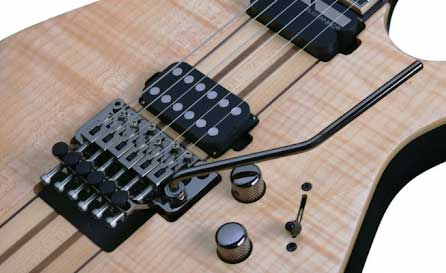

A guitar with a Floyd Rose can look intimidating at first. There are quite a few things you need to know about a Floyd Rose if you are thinking about buying a guitar with one.
In this guide, you will learn:
To learn more about different types of bridges, check out this guide on guitar parts.
Table of Contents showBefore we look at what a Floyd Rose can do, let’s look at what they are so you can identify them when looking at different guitars.
A Floyd Rose is a type of locking tremolo for electric guitars. The Floyd Rose includes a tremolo arm (or whammy bar) that you can push down to lower the guitar’s pitch, or lift to raise the guitar’s pitch.
The below photo shows a typical example of what a Floyd Rose looks like:

While the Floyd Rose looks complicated, it doesn’t take long to learn all of the parts and how to use one.
Here is a photo of a guitar with a Floyd Rose compared to a similar guitar with a ‘standard’ tremolo:

While both guitars have a tremolo arm (or whammy bar), there is a big difference in how these guitars will feel to play and their tuning stability.
To properly understand what a Floyd Rose is and how it works, it helps to understand the different parts.
Here are all of the parts that make up the Floyd Rose system:
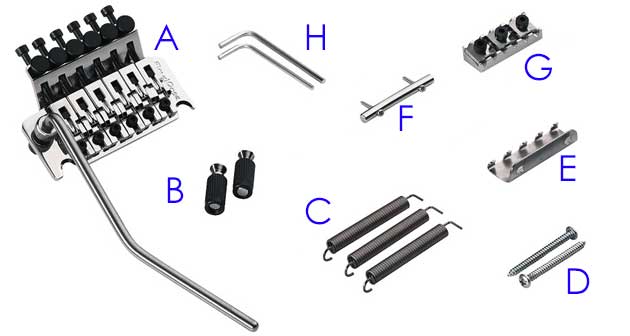
The main parts of a Floyd Rose system are:
As you can see, there are a lot of parts that form part of the Floyd Rose system. They all need to work together in a specific way or else you’ll end up with problems.
Here is a closer look at the bridge and the parts:
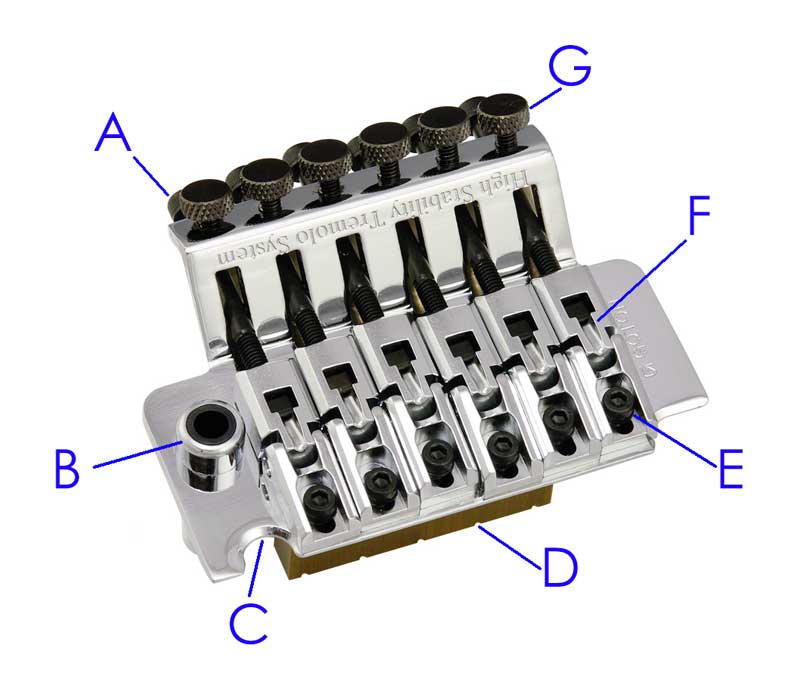
Here are all of the parts and what they do:
If the number of parts feels overwhelming, don’t worry. By the end of this guide, you will have a solid understanding of how the Floyd Rose works and you’ll be able to use one properly.
A Floyd Rose tremolo works by balancing the tension of the strings with tension from springs in the back of the guitar. When the tension is properly balanced, the bridge floats.
In the below photo, you can see how the strings pull the bridge (yellow arrow):
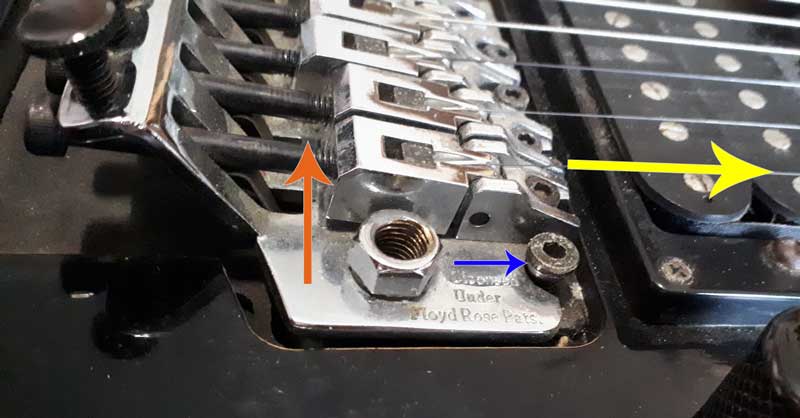
The bridge presses against the mounting posts (blue arrow), so the tension from the strings causes the bridge to rotate up (orange arrow).
If the tension isn’t probably balanced with the springs in the back, the bridge will tilt up. You can see in the above photo that there is a slight up-tilt from the string tension compared to the body of the guitar.
If you remove the back plate, you will see this:

These three springs attach to the tremolo and offset the tension from the strings. The strings pull the tremolo (yellow arrow) back down to stop it from tilting up.
There are five mounting positions for springs, but guitarists typically only use three springs. Changing which position the springs attach or adjusting the screws will change the tension pulling against the strings.
The amount of tension needed to perfectly balance the tremolo depends on the string gauge and tuning.
A light set of strings may only need two springs to balance the tremolo, while a heavy gauge of strings will create more tension.
Key point: if the tension isn’t properly balanced between the springs and the strings, the Floyd Rose won’t sit level.
The below photo shows what happens if you don’t properly balance the tension.

If you see a raised Floyd Rose tremolo like this one, it means the tension from the strings is too much for the springs to offset.
Adding a spring at the back, adjusting the back screws, or lowering the string gauge can help fix this problem.
There are two main reasons why you might want to use a Floyd Rose tremolo. One benefit is the tuning stability. A properly set up Floyd Rose can have fantastic tuning stability.
The other benefit is whammy bar freedom. There are things you can do with a Floyd Rose that you can’t do on non-locking tremolos.
For some guitarists, these benefits are why they only use guitars with a Floyd Rose.
Let’s look closer at these benefits to help you decide whether you might want to use a Floyd Rose tremolo.
When used properly, a Floyd Rose can give you better tuning stability than a standard tremolo bridge.
If you play a dive-bomb (explained later) on a guitar with a standard tremolo, you can pretty much expect your guitar to go out of tune straight away.
Play the same dive-bomb on a Floyd Rose and you should expect it to return to exactly as it was before the dive-bomb.
Trying to play music by guitarists like Joe Satriani or Steve Vai (or anybody else who uses a lot of whammy bar) on a guitar without a Floyd Rose will quickly become a frustrating experience as your guitar will quickly go out of tune.
The tuning stability is achieved by locking the strings into position with a locking nut as shown below:
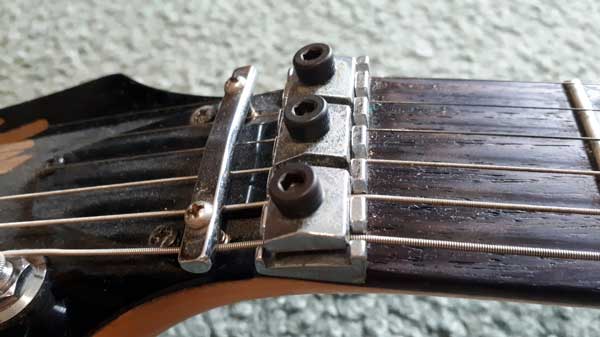
This nut clamps the strings down, so the tuners can’t slip in any way.
A Floyd Rose tremolo allows you to push a whammy bar down or pull it up. Normal tremolo bridges only allow you to push it down to lower the pitch.
While guitarists don’t tend to pull up on the whammy bar very often, a Floyd Rose gives you far more freedom with how you use the whammy bar.
The dive-bomb is the perfect example of how a Floyd Rose tremolo gives you the freedom to use the whammy bar how you want.
A dive-bomb is when you depress the whammy bar as far as possible until your guitar strings become completely slack.
When you return the whammy bar back into the normal position, you can expect your strings to stay in tune (if your Floyd Rose is set up properly).
If you were to try a dive-bomb on a standard tremolo, you can expect it to be horribly out-of-tune afterward.
While the Floyd Rose offers some great benefits compared to other guitar bridges, some guitarists hate them.
If you talk to enough guitarists, you’ll learn that most guitarists either love or hate the Floyd Rose.
Here are the main reasons why some guitarists hate the Floyd Rose.
Some guitars you can pick up and play and not need to ever learn how the bridge works.
If you buy a secondhand guitar with a hardtail bridge and it doesn’t come with any strings, you simply string it up, adjust the intonation and action (links to useful guides), then you’re ready to go.
If you buy a secondhand guitar with a Floyd Rose and it doesn’t come with any strings, you need to put a lot more work to get it set up before you can play it.
A Floyd Rose isn’t hard to set up, but you do need to understand a few things to set it up properly. Some guitarists aren’t willing to spend the time to learn how to set up and maintain a Floyd Rose.
A Floyd Rose works by balancing the tension of the strings with the springs in the back of the guitar. If anything throws off the tension, you need to make adjustments.
Changing to an alternate tuning can easily throw off a Floyd Rose’s balance.
While it’s quick and easy to change back and forth between different tunings on many guitars, it isn’t as easy on a Floyd Rose guitar.
Even changing the string gauge you use can throw the balance off, requiring you to re-balance your bridge.
The Floyd Rose offers tuning stability and whammy bar freedom. But it requires more work than other types of bridges.
Whether a Floyd Rose is right for you or not depends on how much you’ll use a whammy bar.
If you play the type of music that uses a lot of whammy bar action, then you’ll benefit from the freedom and stability in a Floyd Rose.
If you don’t play the type of music that uses a lot of whammy bar action, you won’t get much benefit out of it and there will be other types of bridges that will suit you better.
Of course, you can use a Floyd Rose and not use the whammy bar.
There are a lot of types of bridges, so let’s look at how the Floyd Rose compares to some common alternatives.
A Floyd Rose looks similar to a standard tremolo, but they feel completely different to play. A standard tremolo will go out-of-tune far sooner than a Floyd Rose when you use your whammy bar.
As you can see in the below comparison, both the Floyd Rose and the standard tremolo have a tremolo arm. Both can be depressed to lower the pitch, but the Floyd Rose tremolo arm can also be raised.

Guitars with a standard tremolo don’t normally have a locking nut, while it is standard to have one with a Floyd Rose.
If you only use the whammy bar on occasion and you don’t play aggressive dive-bombs with it, you may find that a standard tremolo gives you all you need without the extra benefits of a Floyd Rose.
The Floyd Rose and the Ibanez Edge are so similar in appearance and features that guitarists talk about them as if they’re the same thing.
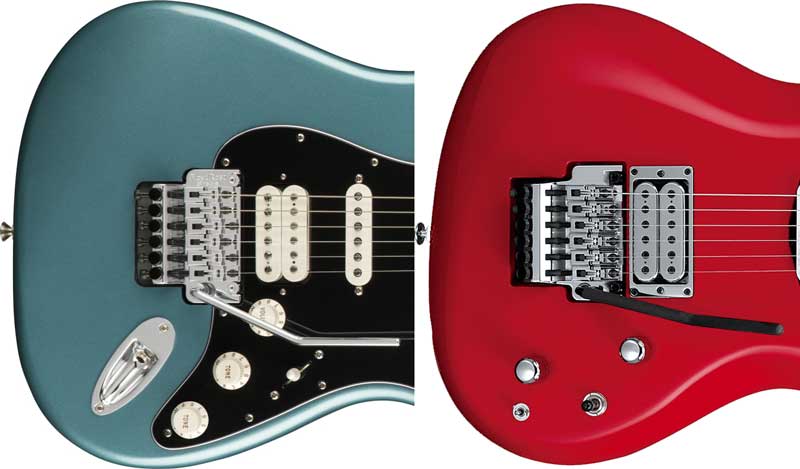
If you’re having trouble telling the two above bridges apart, that’s because they’re basically the same.
If you have an old Ibanez, you may notice the bridge has ‘Licenced Under Floyd Rose Pats.’ stamped on it.
For example, here is the tremolo on my old Ibanez RG270DX:

You may notice a few differences between this tremolo and the previous example.
You can see the licensed stamp across the bridge. This is an old guitar and a pretty cheap model, so you won’t see bridges like this on new Ibanez models.
The other thing you may notice is how the strings connect to the bridge. The strings pass through what is normally the string retainer screw with the ball end in place. You’re unlikely to see newer models with this type of bridge, but they do exist.
If you’re wondering, the reason the last string sticks out of the end is because I use super-heavy gauge strings on this guitar for a low tuning, so it doesn’t quite fit in the end.
The original patent for the Floyd Rose ended in 2003, so newer Ibanez Edge models since then have used many features found in the original Floyd Rose without needing to be licensed.
This is why the earlier photo didn’t have any licensed stamps on it despite it being clearly the same as the Floyd Rose.
While there are different features across the different Edge models, the basic idea is the same as the Floyd Rose.
This means you can buy an Ibanez with an Edge tremolo and use it in the same way as a Floyd Rose.
When comparing the Floyd Rose and the Kahler, a few differences are obvious. The difference with the Kahler is that the tremolo arm is positioned in between the strings on the Kahler, the balls of the strings remain intact, and a cam system is used.

While the Kahler and the Floyd Rose are similar to play, they use different mechanisms to work.
Kahler was a fierce competitor to Floyd Rose in the 80s and you’re likely to find a lot of guitars from that time using a Kahler.
There was an ongoing battle between Floyd Rose and Kahler over patent infringement and eventually, Kahler lost the lawsuit.
When compared against the Floyd Rose, the Bigsby tremolo is easier to use but has a very limited range in how far you can push the tremolo arm. Guitars with a Bigsby tremolo don’t have locking nuts, so you don’t get the tuning stability of the Floyd Rose.
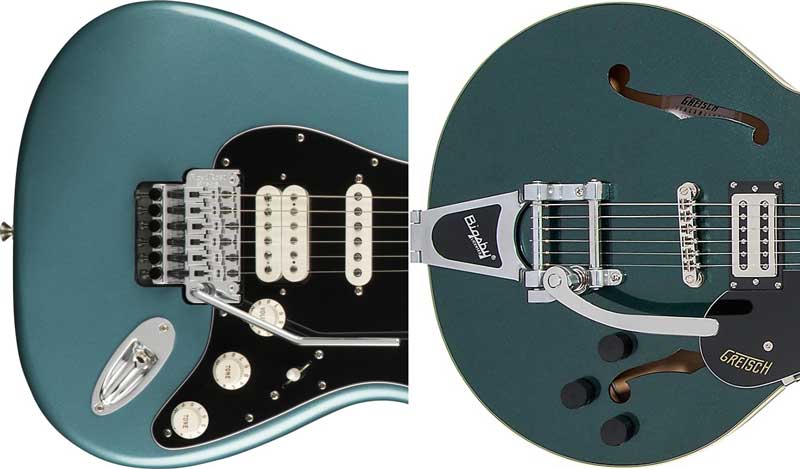
Installing strings in a Bigsby tremolo is as easy as threading it through the holes. The ball ends remain intact, so no tools are required.
You won’t be playing any dive bombs or wide dips with a Bigsby tremolo as they have a very limited range.
The limited range of the Bigsby is fine for vibrato or subtle effects, but that’s the limit of what it is capable of.
The Floyd Rose and Evertune bridges are significantly different in what each one can do. The Floyd Rose is a tremolo with a whammy bar, while the Evertune doesn’t use a whammy bar.

The Evertune is designed to offer the best possible tuning stability. It is completely different from the Floyd Rose and you won’t be able to play any whammy techniques on an Evertune bridge.
If you’re not interested in using a whammy bar but are interested in a guitar with great tuning stability, the Evertune is worth checking out.
But if you want to have any flexibility with any whammy bar techniques, the Evertune isn’t the right bridge to have.
There are two ways you can replace a set of strings on a guitar with a Floyd Rose. You can either replace them one string at a time, or you can replace all of them at once.
Replacing one string at a time is a faster method as it won’t cause issues with releasing too much tension at once.
If you want to replace a set of strings one at a time, replace them in this order: 6th string, 1st string, 5th string, 2nd string, 4th string, 3rd string.
Replacing the strings in this order makes sure you keep a balanced tension on the bridge.
Replacing all strings at once requires you to block the tremolo as removing all of the strings will remove all tension.
The advantage of using this method is it gives you the chance to give your fretboard a good clean.
The below video does a good job of walking you through this process.
Here are some tips to keep in mind when replacing strings with a Floyd Rose:
While changing strings with a Floyd Rose can be frustrating, you’ll quickly get the hang of it.
There are two ways to tune a Floyd Rose guitar. The first way is with the fine tuners at the end of the tremolo. Use the fine tuners for small adjustments in tuning.
The other way is to unlock the strings and use the machine heads. Use the machine heads for major adjustments in tuning.
When the locking nut is tightened, you cannot use the machine heads to tune your guitar. To overcome this problem, fine tuners are positioned at the end of each string on the tremolo.
As you can see from the photo below, as you turn each tuner screw, it pushes down on the string retainer screw:

You can see that the low E string has been adjusted quite a bit compared to the other strings. Each string retainer can be adjusted individually with the fine tuners.
Having two ways to tune a Floyd Rose might seem confusing, but it makes it easier once you understand a few things.
Here is how to tune and keep your Floyd Rose in tune:
Step 1: When you first install a set of strings on your guitar, make sure all the fine tuners are ‘reset’ to a good middle position. All of the string retainer screws should be level in height.
Use the machine heads to tune the strings. It may take you quite a few times to tune the entire guitar because every time you tune the next string, the change in tension will throw the other strings out of tune.
Keep tuning until you notice that the other strings don’t go out of tune anymore.
The Floyd Rose tremolo should be close to level with the body of your guitar. It’s okay if it is slightly raised. If it is raised too high or sinks into the guitar, you need to adjust the screws and springs.
Step 2: Once your guitar is in tune, tighten the locking nuts. This will clamp down on the strings and hold them in position.
Step 3: If your guitar goes out of tune (it takes time for new strings to adjust), use the fine tuners to adjust each string’s tuning.
You should be able to continue playing your guitar and only need to make small adjustments to the fine tuners on occasion.
Step 4: If you find that one or more of your fine tuners has reached their limits, unlock the strings at the nut.
Reset the fine tuner positions and use the machine heads to re-tune your guitar. Then tighten the locking nut and continue to use the fine tuners as you play.
Here are some common questions people have asked me about a Floyd Rose tremolo system.
The purpose of a Floyd Rose tremolo system is to give you freedom to use the tremolo bar as much as you like. The double-locking system improves tuning stability, which means you can do dive-bombs and other whammy techniques.
While there are other tremolo systems that can do similar things, the Floyd Rose is well known for being a great system for guitarists who like to use a whammy bar.
You can put a Floyd Rose in almost any guitar, but the amount of work needed depends on the type of guitar. It’s not recommended for most guitarists due to the modifications a Floyd Rose requires.
A Floyd Rose requires a lot of routed cavities, so installing one in a guitar not meant to use a Floyd Rose will require a lot of irreversible woodwork.
If your guitar doesn’t have a Floyd Rose in it, I don’t recommend installing one unless you know what you’re doing.
A Floyd Rose is worth it if you use the whammy bar a lot and want improved tuning stability. If you don’t play a lot of whammy techniques, you may prefer a standard tremolo or any other type of bridge.
The Floyd Rose has a bigger learning curve to use properly, which means it can be a major hassle if you don’t know what you are doing. If you’re not willing to learn how to properly use a Floyd Rose, then it won’t be worth it.
A Floyd Rose that has been set up properly can stay in excellent tune for weeks or months without needing adjustments. How long a Floyd Rose stays in tune also depends on how much you use the whammy bar and how aggressively you use it.
If you play a lot of aggressive whammy bar techniques, then you can expect it to gradually shift out of tuner sooner than a guitarist who rarely touches the bar.
Higher quality Floyd Rose systems will stay in tune longer than cheaper models.
To keep a Floyd Rose in tune, you need to make sure it is set up properly. Make sure the tension from the strings is perfectly balanced with the strings so the tremolo is level with your guitar.
Once your Floyd Rose is set up properly, you can clamp down the locking nut and should only need to make small adjustments using the fine tuners as you play.
If a Floyd Rose isn’t perfectly set up in the beginning, don’t expect it to stay in tune. Balancing the tension will improve tuning stability.
If your Floyd Rose is sitting really high, it means the tension from the strings is too much for the springs in the back. Add more springs to the back cavity or adjust the back screws to balance the tension.
If your Floyd Rose is as high as the below photo, that’s a clear sign that it hasn’t been set up properly.

Read the earlier information on how to set up a Floyd Rose to understand why this problem happens and how to fix it.
You can change tuning on a Floyd Rose, but it is more complicated than a standard guitar. Changing tuning will change the tension in the strings, which means you need to rebalance the tension for the Floyd Rose to stay in tune.
To change the tuning on a Floyd Rose, you loosen the locking nuts. Change the tuning using the machine heads and keep an eye on the level of the tremolo. Adjust the back screws if needed and retune.
Once you retune your guitar and the tremolo stays level with the body of the guitar, you can clamp the locking nut down.
Changing the tuning on a guitar with a Floyd Rose is a hassle, so if you regularly change back and forth between different tunings, a Floyd Rose is not recommended.
Here are some relevant guides to help you get the most out of your Floyd Rose: